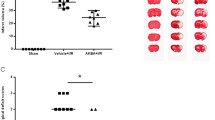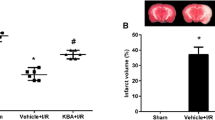Abstract
Acetyl-11-keto-β-boswellic acid (AKBA), a main active constituent from Boswellia serrata resin, is a novel candidate for therapy of cerebral ischemia-reperfusion (I/R) injury. Nevertheless, its poor solubility in aqueous solvent, bioavailability, and rapid clearance limit its curative efficacy. To enhance its potency, in our study, AKBA-loaded o-carboxymethyl chitosan nanoparticle (AKBA-NP) delivery system was synthesized. The transmission electron microscopy and transmission electron microscope images of AKBA-NPs suggested that particle size was 132 ± 18 nm, and particles were spherical in shape with smooth morphology. In pharmacokinetics study, AKBA-NPs apparently increases the area under the curve of plasma concentration-time and prolonged half-life compared with AKBA. The tissue distribution study confirmed that AKBA-NPs had a better brain delivery efficacy in comparison with AKBA. The results from our pharmacodynamic studies showed that AKBA-NPs possess better neuroprotection compared with AKBA in primary neurons with oxygen-glucose deprivation (OGD) model and in animals with middle cerebral artery occlusion (MCAO) model. Additionally, AKBA-NPs modulate antioxidant and anti-inflammatory pathways more effectively than AKBA by increasing nuclear erythroid 2-related factor 2 and heme oxygenase-1 expression, and by decreasing nuclear factor-kappa B and 5-lipoxygenase expression. Collectively, our results suggest that AKBA-NPs serve as a potent delivery vehicle for AKBA in cerebral ischemic therapy.






Similar content being viewed by others
Abbreviations
- AKBA:
-
Acetyl-11-keto-β-boswellic acid
- AKBA-NPs:
-
AKBA-loaded o-carboxymethyl chitosan nanoparticles
- EPR:
-
Enhanced permeability and retention
- GPx:
-
Glutathione peroxidase
- IL-1β:
-
Interleukin-1β
- I/R:
-
Ischemia-reperfusion
- HO-1:
-
Heme oxygenase-1
- 5-LOX:
-
5-Lipoxygenase
- MCAO:
-
Middle cerebral artery occlusion
- MDA:
-
Malondialdehyde
- MTT:
-
3-[4,5-Dimethylthiazol-2-yl]-2,5-diphenyltetrazolium bromide
- Nrf2:
-
Nuclear factor erythroid-2-related factor 2
- NF-κB:
-
Nuclear factor kappa-beta
- O-CMC:
-
O-Carboxymethyl chitosan
- OGD:
-
Oxygen and glucose deprivation
- SD:
-
Standard deviation
- SEM:
-
Scanning electron microscope
- SOD:
-
Superoxide dismutase
- TNF-α:
-
Tumor necrosis factor-α
- TTC:
-
2,3,5-Triphenyltetrazolium chloride
- TUNEL:
-
Terminal deoxynucleotidyl transferase dUTP nick-end labeling
References
Go AS, Mozaffarian D, Roger VL, Benjamin EJ, Berry JD, Borden WB, Bravata DM, Dai S et al (2013) Heart disease and stroke statistics—2013 update: a report from the American Heart Association. Circulation 127(1):e6–e245. doi:10.1161/CIR.0b013e31828124ad
Iadecola C, Anrather J (2011) Stroke research at a crossroad: asking the brain for directions. Nat Neurosci 14(11):1363–1368
Marder VJ, Jahan R, Gruber T, Goyal A, Arora V (2010) Thrombolysis with plasmin: implications for stroke treatment. Stroke J Cereb Circ 41(10 Suppl):S45–S49. doi:10.1161/STROKEAHA.110.595157
Ernst E (2008) Frankincense: systematic review. BMJ 337:a2813. doi:10.1136/bmj.a2813
Ammon HP (2006) Boswellic acids in chronic inflammatory diseases. Planta Med 72(12):1100–1116. doi:10.1055/s-2006-947227
Moussaieff A, Mechoulam R (2009) Boswellia resin: from religious ceremonies to medical uses; a review of in-vitro, in-vivo and clinical trials. J Pharm Pharmacol 61(10):1281–1293. doi:10.1211/jpp/61.10.0003
Kirste S, Treier M, Wehrle SJ, Becker G, Abdel-Tawab M, Gerbeth K, Hug MJ, Lubrich B et al (2011) Boswellia serrata acts on cerebral edema in patients irradiated for brain tumors: a prospective, randomized, placebo-controlled, double-blind pilot trial. Cancer 117(16):3788–3795. doi:10.1002/cncr.25945
Skarke C, Kuczka K, Tausch L, Werz O, Rossmanith T, Barrett JS, Harder S, Holtmeier W et al (2012) Increased bioavailability of 11-keto-beta-boswellic acid following single oral dose frankincense extract administration after a standardized meal in healthy male volunteers: modeling and simulation considerations for evaluating drug exposures. J Clin Pharmacol 52(10):1592–1600. doi:10.1177/0091270011422811
Ding Y, Chen M, Wang M, Wang M, Zhang T, Park J, Zhu Y, Guo C et al (2014) Neuroprotection by acetyl-11-keto-beta-boswellic acid, in ischemic brain injury involves the Nrf2/HO-1 defense pathway. Sci Rep 4:7002. doi:10.1038/srep07002
Sailer ER, Subramanian LR, Rall B, Hoernlein RF, Ammon H, Safayhi H (1996) Acetyl‐11‐keto‐β‐boswellic acid (AKBA): structure requirements for binding and 5-lipoxygenase inhibitory activity. Br J Pharmacol 117(4):615–618
Cuaz-Pérolin C, Billiet L, Baugé E, Copin C, Scott-Algara D, Genze F, Büchele B, Syrovets T et al (2008) Antiinflammatory and antiatherogenic effects of the NF-κB inhibitor acetyl-11-keto-β-boswellic acid in LPS-challenged ApoE−/− mice. Arterioscler Thromb Vasc Biol 28(2):272–277
Karlina M, Pozharitskaya O, Kosman V, Ivanova S (2007) Bioavailability of boswellic acids: in vitro/in vivo correlation. Pharm Chem J 41(11):569–572
Kruger P, Daneshfar R, Eckert GP, Klein J, Volmer DA, Bahr U, Muller WE, Karas M et al (2008) Metabolism of boswellic acids in vitro and in vivo. Drug Metab Dispos Biol Fate Chem 36(6):1135–1142. doi:10.1124/dmd.107.018424
Cho Y, Shi R, Borgens RB (2010) Chitosan produces potent neuroprotection and physiological recovery following traumatic spinal cord injury. J Exp Biol 213(9):1513–1520
Lee HJ, Park J, Yoon OJ, Kim HW, Kim DH, Lee WB, Lee N-E, Bonventre JV et al (2011) Amine-modified single-walled carbon nanotubes protect neurons from injury in a rat stroke model. Nat Nanotechnol 6(2):121–125
De Giglio E, Trapani A, Cafagna D, Sabbatini L, Cometa S (2011) Dopamine-loaded chitosan nanoparticles: formulation and analytical characterization. Anal Bioanal Chem 400(7):1997–2002. doi:10.1007/s00216-011-4962-y
Xie YT, Du YZ, Yuan H, Hu FQ (2012) Brain-targeting study of stearic acid-grafted chitosan micelle drug-delivery system. Int J Nanomedicine 7:3235–3244. doi:10.2147/Ijn.S32701
Malatesta M, Galimberti V, Cisterna B, Costanzo M, Biggiogera M, Zancanaro C (2014) Chitosan nanoparticles are efficient carriers for delivering biodegradable drugs to neuronal cells. Histochem Cell Biol 141(5):551–558. doi:10.1007/s00418-013-1175-9
Mistry A, Stolnik S, Illum L (2009) Nanoparticles for direct nose-to-brain delivery of drugs. Int J Pharmaceut 379(1):146–157. doi:10.1016/j.ijpharm.2009.06.019
Zhao L, Zhu B, Jia Y, Hou W, Su C (2013) Preparation of biocompatible carboxymethyl chitosan nanoparticles for delivery of antibiotic drug. BioMed Res Int 2013:236469. doi:10.1155/2013/236469
Smitha KT, Sreelakshmi M, Nisha N, Jayakumar R, Biswas R (2014) Amidase encapsulated O-carboxymethyl chitosan nanoparticles for vaccine delivery. Int J Biol Macromol 63:154–157. doi:10.1016/j.ijbiomac.2013.10.045
Nagpal K, Singh SK, Mishra DN (2013) Formulation, optimization, in vivo pharmacokinetic, behavioral and biochemical estimations of minocycline loaded chitosan nanoparticles for enhanced brain uptake. Chem Pharm Bull 61(3):258–272
Reising K, Meins J, Bastian B, Eckert G, Mueller WE, Schubert-Zsilavecz M, Abdel-Tawab M (2005) Determination of boswellic acids in brain and plasma by high-performance liquid chromatography/tandem mass spectrometry. Anal Chem 77(20):6640–6645. doi:10.1021/ac0506478
Wu J, Li Q, Wang X, Yu S, Li L, Wu X, Chen Y, Zhao J et al (2013) Neuroprotection by curcumin in ischemic brain injury involves the Akt/Nrf2 pathway. PLoS One 8(3):e59843. doi:10.1371/journal.pone.0059843
Deng B, Gou X, Chen H, Li L, Zhong H, Xu H, Jiang F, Zhao Z et al (2013) Targeted delivery of neurogenin-2 protein in the treatment for cerebral ischemia-reperfusion injury. Biomaterials 34(34):8786–8797. doi:10.1016/j.biomaterials.2013.07.076
Longa EZ, Weinstein PR, Carlson S, Cummins R (1989) Reversible middle cerebral artery occlusion without craniectomy in rats. Stroke J Cereb Circ 20(1):84–91
Lu Y-M, Huang J-Y, Wang H, Lou X-F, Liao M-H, Hong L-J, Tao R-R, Ahmed MM et al (2014) Targeted therapy of brain ischaemia using Fas ligand antibody conjugated PEG-lipid nanoparticles. Biomaterials 35(1):530–537
Rubin L, Staddon J (1999) The cell biology of the blood-brain barrier. Annu Rev Neurosci 22(1):11–28
Huwyler J, Wu D, Pardridge WM (1996) Brain drug delivery of small molecules using immunoliposomes. Proc Natl Acad Sci 93(24):14164–14169
Stolnik S, Illum L, Davis S (2012) Long circulating microparticulate drug carriers. Adv Drug Deliv Rev 64:290–301
Durukan A, Tatlisumak T (2007) Acute ischemic stroke: overview of major experimental rodent models, pathophysiology, and therapy of focal cerebral ischemia. Pharmacol Biochem Behav 87(1):179–197. doi:10.1016/j.pbb.2007.04.015
Chan PH (1994) Oxygen radicals in focal cerebral ischemia. Brain Pathol 4(1):59–65
Siesjo BK, Agardh CD, Bengtsson F (1989) Free radicals and brain damage. Cerebrovasc Brain Metab Rev 1(3):165–211
Ding Y, Chen M, Wang M, Li Y, Wen A (2014) Posttreatment with 11-keto-β-boswellic acid ameliorates cerebral ischemia–reperfusion injury: Nrf2/HO-1 pathway as a potential mechanism. Mol Neurobiol 1–10. doi:10.1007/s12035-014-8929-9
Ding Y, Zhang B, Zhou K, Chen M, Wang M, Jia Y, Song Y, Li Y et al (2014) Dietary ellagic acid improves oxidant-induced endothelial dysfunction and atherosclerosis: role of Nrf2 activation. Int J Cardiol 175(3):508–514. doi:10.1016/j.ijcard.2014.06.045
Maines MD (1988) Heme oxygenase: function, multiplicity, regulatory mechanisms, and clinical applications. FASEB J Off Publ Fed Am Soc Exp Biol 2(10):2557–2568
Loetscher H, Gentz R, Zulauf M, Lustig A, Tabuchi H, Schlaeger EJ, Brockhaus M, Gallati H et al (1991) Recombinant 55-kDa tumor necrosis factor (TNF) receptor. Stoichiometry of binding to TNF alpha and TNF beta and inhibition of TNF activity. J Biol Chem 266(27):18324–18329
Touzani O, Boutin H, Chuquet J, Rothwell N (1999) Potential mechanisms of interleukin-1 involvement in cerebral ischaemia. J Neuroimmunol 100(1):203–215
Killeen MJ, Linder M, Pontoniere P, Crea R (2014) NF-kappabeta signaling and chronic inflammatory diseases: exploring the potential of natural products to drive new therapeutic opportunities. Drug Discov Today 19(4):373–378. doi:10.1016/j.drudis.2013.11.002
Siemoneit U, Hofmann B, Kather N, Lamkemeyer T, Madlung J, Franke L, Schneider G, Jauch J et al (2008) Identification and functional analysis of cyclooxygenase-1 as a molecular target of boswellic acids. Biochem Pharmacol 75(2):503–513
Acknowledgments
This research was financially supported by the Key Technologies for New Drug Innovation and Development of China (Nos. 2011ZXJ09202-13 and 2012BAK25B00) and the National Natural Science Foundation of China (Nos. 81373947 and 81201985).
Author information
Authors and Affiliations
Corresponding authors
Additional information
Yi Ding and Youbei Qiao contributed equally to this work.
Rights and permissions
About this article
Cite this article
Ding, Y., Qiao, Y., Wang, M. et al. Enhanced Neuroprotection of Acetyl-11-Keto-β-Boswellic Acid (AKBA)-Loaded O-Carboxymethyl Chitosan Nanoparticles Through Antioxidant and Anti-Inflammatory Pathways. Mol Neurobiol 53, 3842–3853 (2016). https://doi.org/10.1007/s12035-015-9333-9
Received:
Accepted:
Published:
Issue Date:
DOI: https://doi.org/10.1007/s12035-015-9333-9




